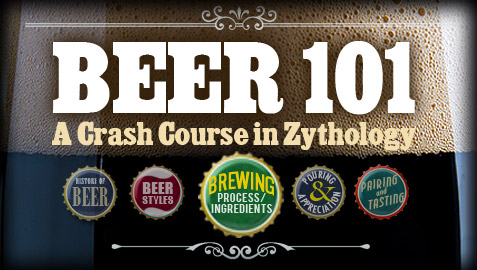Beer 101: The brewing process and ingredients

Over the last decade, craft beer culture has exploded. There are now more than 1600 breweries operating in the US alone, a number that continues to grow year after year. Beer 101 is a guide to understanding the history of brewing, beer culture, and (my favorite part) the enjoyment of good beer.
Part 2 – Brewing Process and Ingredients
Last weekend I put together a brief history of beer, bringing you through thousands of years of history in just a few hundred words. Sorry for the delay this weekend – I ended up flying to LA for the Spike Video Game Awards. For this week’s post, I’ll be walking you through the basics of the brewing process, a process every enthusiast should know since it informs so much about the way a beer looks, feels, and tastes.
As I mentioned in last week’s post, beer is essentially brewed with four ingredients: water, yeast, hops, and malted grain. There are all sorts of ways to modify the process, but for our purposes, this ingredient list will do just fine. Of those four ingredients, yeast is the really important one. If your yeast goes bad, everything goes bad. Yeast is the miracle ingredient that makes the entire process possible.
First, you steep your malt. Steeping is just what it sounds like – soaking your grain in water, which prepares it for germination. Soaking the grain activates the growth process. Little rootlets start to sprout from the grain and the starches in the grain begin to break down. Once the germination process is complete, you have what is known as ‘green malt.’
Next, the grain goes to the kiln to dry. The kiln process, along with the type of grain used, is what gives the malt its character. Pale malts are dried and lower temperatures than, say, ale malts, which will also produce deeper color in the final product. Once dry, the grain has to be cracked in order to better absorb water during mashing. This cracking is called milling.
The milled grain is now mixed with warm water in what is known as the mash tun. The warm water helps convert the starches from the malting phase into sugars, which the yeast will then be able to consume, creating the alcohol and carbonation in the beer. The sugar-rich water gets strained through the mash and becomes wort.
We’ve finally reached the part of the process we know as brewing. The wort is boiled, causing a lot of different chemical changes to take place. This is where a craft brewer develops most of the flavor in a beer. Hops are added at different stages to produce varied results. Bitterness, aroma, and acidity are all determined, in part, by the moment the different hops are added to the brew kettle.
From brewing, the wort gets cooled as quickly as possible. Rapid cooling preserves the character of the wort and makes it temperate enough for yeast to live and work. Once cooled, the wort heads to a fermentation tank, where the brewer selects the yeast and adds it to the wort. Different yeast strains produce different results, again altering the flavor profile and character of the beer. Also, certain yeasts can live in higher alcohol concentrations than others, allowing higher ABV beers. The next step of the process is known as racking. The beer is transferred from the fermentation tank to a conditioning tank to allow the beer to age. Finally, the beer is ready to be filtered and carbonated, a process known as finishing. Once finished, the beer goes to a holding tank until it can be bottled or kegged.
That’s brewing in a small, tightly compressed nutshell. There are all sorts of ways to embellish this process, and while some of my descriptions are short, several of these processes can get complicated, especially on a large scale. It’s a difficult thing to produce the exact same beer time and time again, but with careful monitoring and the latest brewing technology, it can be done.
Come back next week for a discussion of the many different styles of beer, and in the meantime, check out A-B InBev’s iLoveBeer iPhone app (iTunes Link) – it’s a surprisingly solid look at several different beer styles. I won’t be able to cover them all, but I promise to give you a look at brews both strange and exotic.
Related Posts
You can follow us on Twitter and Facebook for content updates. Also, sign up for our email list for weekly updates and check us out on Google+ as well.










